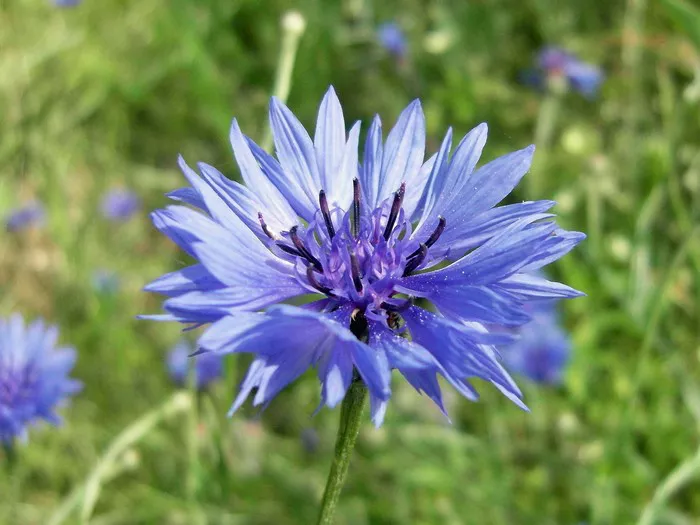Cornflowers, with their vibrant blue blooms, are a charming addition to any garden. Also known as bachelor’s buttons, these hardy annuals are relatively easy to grow, making them a favorite among both novice and experienced gardeners alike. In this comprehensive guide, we will delve into everything you need to know about cultivating and caring for cornflowers in your garden.
Choosing the Right Varieties
Before delving into the specifics of growing cornflowers, it’s important to understand the different varieties available. While the traditional blue cornflower (Centaurea cyanus) is the most popular, there are also white, pink, and purple varieties to choose from. Additionally, there are single and double-flowered cultivars, each with its own unique charm.
When selecting cornflower seeds or seedlings, consider factors such as your garden’s sunlight exposure, soil type, and desired aesthetic. Some varieties may thrive in full sun, while others prefer partial shade. Similarly, certain cultivars may be better suited to well-draining soil, while others can tolerate poorer soils.
Preparing the Soil
Cornflowers are adaptable plants that can grow in a variety of soil conditions, but they prefer well-draining soil with a slightly acidic to neutral pH. Before planting, prepare the soil by loosening it with a garden fork or tiller to a depth of at least 6 inches. Remove any weeds, rocks, or debris that may inhibit growth.
If your soil is heavy or clay-like, consider amending it with organic matter such as compost or aged manure to improve drainage and fertility. This will provide cornflowers with the nutrients they need to thrive throughout the growing season.
Planting Cornflowers
Cornflowers can be grown from either seeds or seedlings, depending on your preference and timing. If starting from seeds, sow them directly into the garden bed in early spring after the last frost date. Scatter the seeds thinly and cover them with a thin layer of soil, pressing gently to ensure good seed-to-soil contact.
If starting from seedlings, transplant them into the garden bed once they have developed a few sets of true leaves. Space the seedlings 6 to 12 inches apart, depending on the variety, to allow for adequate airflow and room to grow.
Water the newly planted seeds or seedlings thoroughly and continue to keep the soil evenly moist until germination occurs, typically within 7 to 14 days. Once established, cornflowers are relatively drought-tolerant and only require supplemental watering during periods of prolonged dryness.
Caring for Cornflowers
Cornflowers are low-maintenance plants that require minimal care once established. However, there are a few key practices to keep in mind to ensure optimal growth and blooming:
Watering: While cornflowers are drought-tolerant once established, they will benefit from regular watering, especially during periods of hot, dry weather. Water deeply at the base of the plants to encourage deep root growth and avoid wetting the foliage, which can lead to disease.
Fertilizing: Cornflowers are not heavy feeders, but they will benefit from a light application of balanced fertilizer, such as a 10-10-10 formula, in early spring before new growth begins. Avoid over-fertilizing, as this can lead to excessive foliage growth at the expense of blooms.
Deadheading: To prolong blooming and encourage continuous flowering, deadhead spent blooms regularly throughout the growing season. Simply pinch or snip off faded flowers at their base to prevent the plant from setting seed and redirect its energy into producing new blooms.
Support: While most cornflower varieties have sturdy stems that can support themselves, taller or double-flowered cultivars may benefit from staking or support cages to prevent them from flopping over in windy conditions or heavy rain.
Pest and Disease Management
Cornflowers are relatively pest and disease-resistant, but they can occasionally fall victim to common garden pests such as aphids, spider mites, and slugs. Monitor your plants regularly for signs of infestation, such as distorted foliage, yellowing leaves, or sticky residue.
If pests are detected, treat the affected plants promptly with insecticidal soap, neem oil, or a homemade organic pesticide to minimize damage and prevent further spread. Additionally, practice good garden hygiene by removing debris and weeds that may harbor pests and diseases.
In terms of diseases, cornflowers can be susceptible to fungal infections such as powdery mildew and rust in humid or poorly ventilated conditions. To prevent these diseases, ensure adequate spacing between plants to promote airflow, and avoid overhead watering, which can promote fungal growth.
Harvesting Cornflowers
In addition to their ornamental value, cornflowers are also prized for their edible and medicinal properties. The petals can be harvested throughout the growing season for use in culinary dishes, herbal teas, and decorative crafts.
To harvest cornflower petals, wait until the flowers are fully open and the petals are at their peak color and fragrance. Gently pinch or snip the petals from the flower head, being careful not to damage the surrounding foliage. Use the petals fresh or dry them for later use by spreading them in a single layer on a drying rack in a warm, well-ventilated area away from direct sunlight.
Conclusion
Growing cornflowers is a rewarding endeavor that offers beautiful blooms, edible petals, and medicinal benefits. By following the guidelines outlined in this comprehensive guide, you can cultivate healthy cornflower plants that will brighten your garden and provide enjoyment for years to come. Whether you’re a seasoned gardener or a novice enthusiast, cornflowers are sure to delight with their easygoing nature and stunning floral display.


